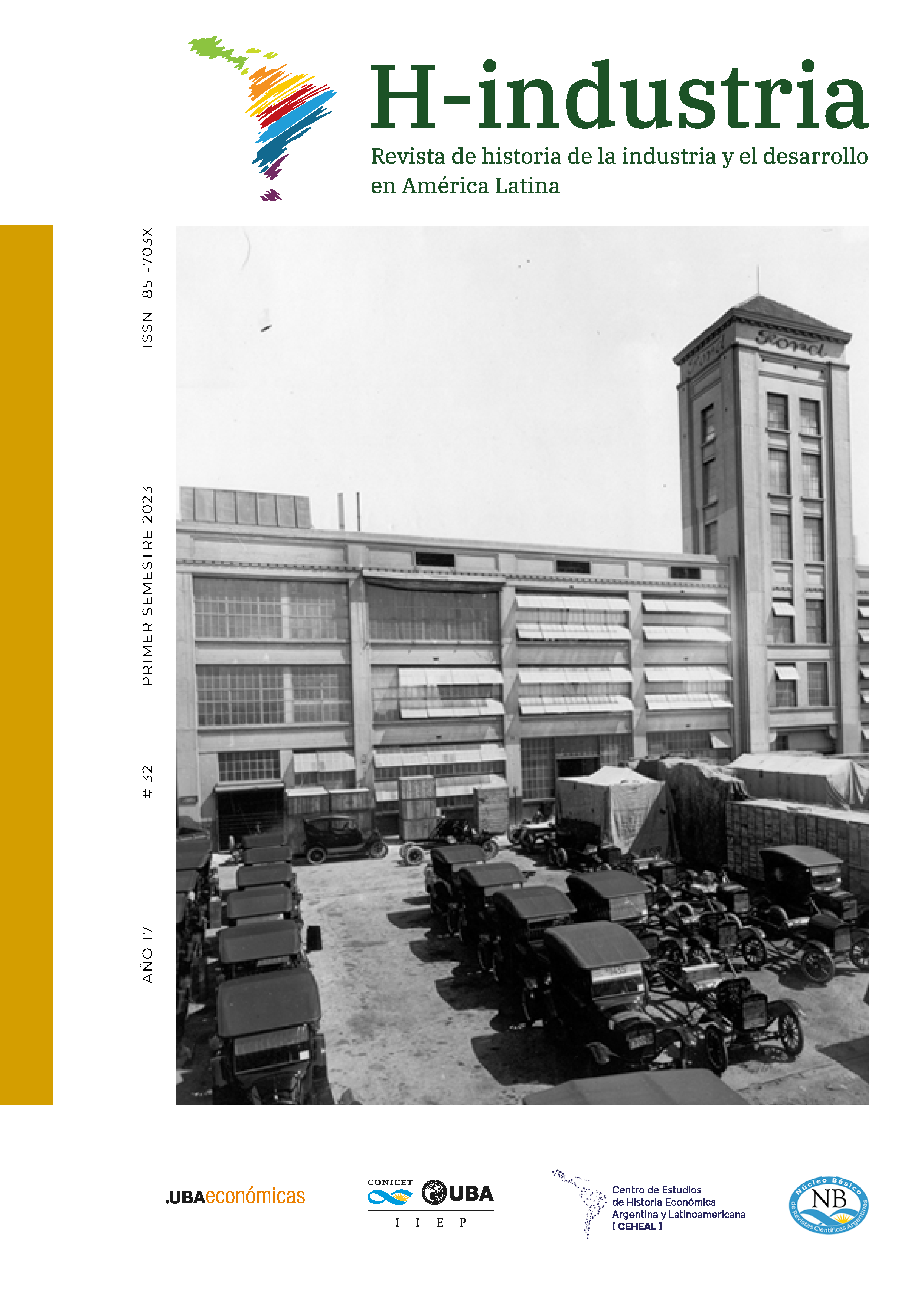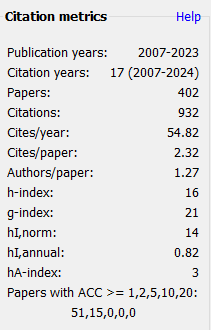The Cattle Business in Argentina
The Domestic Market and the UK Market from 1935 to 1958 and beyond
Resumen
This article analyses trends in the markets for Argentina’s cattle and beef during the period in which its dominant position in the world beef market gradually declined. It looks at conflicting pressures from domestic and export markets for beef, the dilemmas of producers, the need for price guarantees and subsidies, and related political conflicts after the war, making observations about the resilience of cattle production in Argentina.
Descargas
Citas
Argentine Meat. (1949, February 5). The Times.
Balsa, J. (2001). Las formas de producción predominantes en la agricultura pampeana al final de la primera expansión agrícola (1937) ¿Una vía "argentina" de desarrollo del capi¬talismo en el agro?. Mundo Agrario, 3(2).
Barsky, O. y Gelman, J. (2009). Historia del Agro Argentino. Sudamericana).
Basualdo, M. (2010). Argentina y la economía internacional de la carne vacuna entre 1930 y mas allá de los años 90. Estado, frigoríficos y ganaderos pampeanos, [Tesis doctoral] Universidad de Gra¬nada). https://digibug.ugr.es/bitstream/handle/10481/44459/26135954.pdf?s equence=6&isAllowed=y
Blanco, M. (2007). Arrendamientos rurales en la Provincia de Buenos Aires, entre la ley y la práctica, 1940-1960. Mundo Agrario, 14(7).
Board of Trade. (1938). Report of the Joint Committee of Enquiry into the Anglo Argentine Meat Trade. His Majesty´s Stationery Office.
Bowers, J.K. (1985). British Agricultural Policy since the Second World War. Agricultural His¬tory Journal, (33), 66-76.
Censo Agropecuario Nacional 2018. (2021). Resultados Definitivos. Instituto Nacional de Esta¬dísticas y Censos.
Contreras, G. N. (2013). Las tendencias peronistas en la Federación de la Carne: prácticas gremiales y proyecciones políticas, 1946-55. Anuario del IEHS (28), 17-35.
Ferreres, Orlando J. (2010). Dos Siglos de economía argentina (1810-2010). Norte y Sur.
Foreign Office (1950, December 28). Report of meeting between Ernie Bevin and Carlos Hogan. UK National Archives, Foreign Office, 371/4094.
Gebhardt, R. C. (2000). The River Plate Meat Industry since c 1900: technology, ownership international trade regimes and domestic policy’. [PhD Tesis] London School of Economics. http://etheses.lse.ac.uk/1512/1/U118849.pdf
Giberti, H. (1981). Historia Económica de la Ganadería Argentina. Solar.
Girbal Blacha, N. (2002). Políticas públicas para el agro se ofrecen. Llamar al estado peronista (1943-1955), Mundo Agrario 5(3).
Godley, A. and Williams, B. (2009). Democratising Luxury and the Contentious ‘Invention of the Technological Chicken’ in Britain. Business History Review, (83), 267-290.
Hammond, R.J. (1962). Food: Studies in Administration and Control, Volume 3. His Majesty´s Stationery Office.
Heath-Agnew, E. (1983). A History of Hereford Cattle and their breeders. Duckworth.
Imaz, J. L. de. (1962). ‘Estratificación social del sector primario en Ucacha’, Desarrollo Econó¬mico, (1), 1962, 47-61.
Imported Meat Prices (1925, January 22). The Times.
Lema, D. (2020). ‘Precios, producción y productividad en el agro argentino entre 1946 y 1955’, En R. Cortés Conde, et al., La Economía de Perón. Una historia económica, 1946-55, Edhasa.
Liebig’s Extract of Meat (1947, March 6). The Times.
Liebig’s Extract of Meat (1950, March 15). The Times.
Malamud, C. D. (1992). Lisandro de la Torre y el Debate de las Carnes. Anuario del IEHS, (7), 137-65.
Mallory, L. (1950, November 17). [To State Department]. Foreign Relations of the United States (FRUS), Washington, Department of State, Vol. 2, Document 386.
Meat Shippers’ Troubles (1963, June 22). The Times.
Ministry of Agriculture, Fisheries and Food (1958, October 16), UK National Archives, Mi¬nistry of Food, 246/198, memo.
Palacio, Juan Manuel. (2004). La Paz del Trigo, Edhasa.
Peffer, E. L. (1960). The Argentine Cattle Industry under Perón’. Food Science Research Institute Studies, (1), 151-84, https://ideas.repec.org/s/ags/frisst2.html
Peffer, E L. (1961). State Intervention in the Argentine Meat Packing Industry, 1946-1958. Food Science Research Institute Studies, (2), 33-73, https://ideas.repec.org/s/ags/ frisst2.html
Profits on Meat (1926, December 3). The Times
Ray, G. (1949a, March 29). [To State Department]. Foreign Relations of the United States (FRUS), Washington, Department of State, Vol. 2, Document 312.)
Ray, G. (1949b, March 18) [To State Department]. Foreign Relations of the United States (FRUS), Washington, Department of State, Vol 2, Document 308.
Rippy, J. F. (1977). British Investments in Latin America, 1822-1949. Arno Press.
Rooth, T. (1993). British Protecionism and the international economy: overseas commercial policy in the 1930s. Cambridge University Press.
Royal Mail Lines, Limited (1964, May 28). The Times.
Royal Mail Lines, Limited (1964, June 3). The Times.
Sábato, J. F. (1988). La Clase Dominante en la Argentina Moderna. Formación y características, CISEA.
Saccomanno, J. M. (2014). Los Ganaderos argentinos y el frigorífico nacional. El caso de la CAP, (1934-1976) [Tesis de Maestría, Universidad Torcuato di Tella]. https://repositorio. utdt.edu/handle/utdt/1627?show=full
Sáenz Quesada, M.. (2010). Los estancieros. Desde la época colonial hasta nuestros días. Sudameri¬cana.
Taylor, C. (1948). Rural Life in Argentina, Baton Rouge.
Turner Report on 1946 Meat contract negotiations. (1946). UK National Archives, T 236/531.
Voth, K. (2016), in On Pasture, July 2016, online at www.onpasture.com.
Winsberg, M. (1970). The introduction and diffusion of the Aberdeen Angus in Argentina. Geography, (55), 187-95.
Aquellos autores/as que tengan publicaciones con esta revista, aceptan los términos siguientes:
- Los autores/as conservarán sus derechos de autor y garantizarán a la revista el derecho de primera publicación de su obra, el cuál estará simultáneamente sujeto a la Licencia de reconocimiento de Creative Commons Atribución-NoComercial-CompartirIgual 4.0 Internacional (CC BY-NC-SA 4.0) que permite a terceros copiar y redistribuir el material en cualquier medio o formato y adaptar — remezclar, transformar y construir a partir del material bajo la la misma licencia del original. En todos los casos, debe dar crédito de manera adecuada.
- Los autores/as podrán adoptar otros acuerdos de licencia no exclusiva de distribución de la versión de la obra publicada (p. ej.: depositarla en un archivo telemático institucional o publicarla en un volumen monográfico) siempre que se indique la publicación inicial en esta revista.
- Se permite y recomienda a los autores/as difundir su obra a través de Internet (p. ej.: en archivos telemáticos institucionales o en su página web) antes y durante el proceso de envío, lo cual puede producir intercambios interesantes y aumentar las citas de la obra publicada. (Véase El efecto del acceso abierto).
 Esta obra está bajo una Licencia Creative Commons Atribución-NoComercial-CompartirIgual 4.0 Internacional.
Esta obra está bajo una Licencia Creative Commons Atribución-NoComercial-CompartirIgual 4.0 Internacional.




